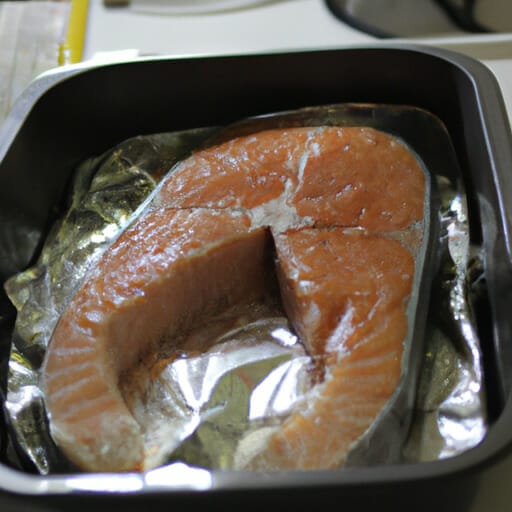Cooking salmon correctly is essential for a delicious and safe meal. Knowing when salmon is fully cooked is important to ensure that it is cooked through and safe to eat. There are several ways to tell if salmon is cooked, including visual cues, temperature, and texture. This article will provide tips on how to tell if salmon is fully cooked and provide information on the safe internal temperature for cooked salmon.
How to Tell If Salmon Is Fully Cooked: A Step-by-Step Guide
Contents
- 1 How to Tell If Salmon Is Fully Cooked: A Step-by-Step Guide
- 2 The Benefits of Eating Fully Cooked Salmon
- 3 What Temperature Should Salmon Be Cooked To?
- 4
- 5 How to Avoid Overcooking Salmon
- 6 The Best Cooking Methods for Salmon
- 7 How to Tell If Salmon Is Done Without a Thermometer
- 8 What Color Should Salmon Be When Fully Cooked?
- 9 How to Reheat Fully Cooked Salmon Safely
- 10 Conclusion
Cooking salmon can be intimidating, but it doesn’t have to be! Here’s a step-by-step guide to help you tell if your salmon is fully cooked.
Step 1: Check the Color. Fully cooked salmon should be an opaque pinkish-orange color. If it’s still translucent, it needs more time in the pan or oven.
Step 2: Check the Texture. Fully cooked salmon should be firm and flaky. If it’s still soft and mushy, it needs more time.
Step 3: Check the Temperature. The best way to tell if your salmon is fully cooked is to use a food thermometer. Insert the thermometer into the thickest part of the salmon and check the temperature. Fully cooked salmon should be at least 145°F.
Now that you know how to tell if your salmon is fully cooked, you can enjoy your delicious meal with confidence!
The Benefits of Eating Fully Cooked Salmon
Eating fully cooked salmon is a great way to get the most out of this delicious fish. Not only is it packed with essential nutrients, but it is also incredibly easy to prepare. Here are some of the benefits of eating fully cooked salmon:
1. Nutritional Value: Salmon is an excellent source of protein, omega-3 fatty acids, and vitamins and minerals. It is also low in calories and saturated fat, making it a healthy choice for those looking to maintain a balanced diet.
2. Convenience: Fully cooked salmon is incredibly convenient. It can be found in the frozen section of most grocery stores and can be quickly and easily prepared in a variety of ways.
3. Versatility: Fully cooked salmon can be used in a variety of dishes, from salads to sandwiches to pasta dishes. It can also be served as a main course or as a side dish.
4. Taste: Fully cooked salmon has a mild, yet flavorful taste that is sure to please even the pickiest of eaters.
Eating fully cooked salmon is a great way to get the most out of this delicious fish. Not only is it packed with essential nutrients, but it is also incredibly easy to prepare. With its nutritional value, convenience, versatility, and delicious taste, fully cooked salmon is a great choice for any meal. So why not give it a try today?
What Temperature Should Salmon Be Cooked To?
Salmon is a delicious and nutritious fish that can be cooked in a variety of ways. For the best results, salmon should be cooked to an internal temperature of 145°F. This temperature ensures that the salmon is cooked through and is safe to eat. To check the temperature, insert an instant-read thermometer into the thickest part of the fish. When the thermometer reads 145°F, the salmon is ready to enjoy!
How to Avoid Overcooking Salmon
Cooking salmon can be a tricky business, but it doesn’t have to be! Here are some tips to help you avoid overcooking your salmon and enjoy a delicious meal.
1. Start with the right cut of salmon. Look for a thick, center-cut fillet that is at least one inch thick. This will help ensure that the salmon cooks evenly and doesn’t dry out.
2. Preheat your oven or grill to the right temperature. For oven-baked salmon, preheat to 375°F. For grilled salmon, preheat to medium-high heat.
3. Use a thermometer to check the internal temperature of the salmon. The internal temperature should reach 145°F for medium-rare, or 155°F for medium.
4. Cook the salmon for the right amount of time. For oven-baked salmon, cook for 8-10 minutes per inch of thickness. For grilled salmon, cook for 4-6 minutes per side.
5. Let the salmon rest for a few minutes before serving. This will help ensure that the salmon is cooked evenly and doesn’t dry out.
Following these tips will help you avoid overcooking your salmon and enjoy a delicious meal. Bon appétit!
The Best Cooking Methods for Salmon
Salmon is one of the most popular and delicious fish out there, and it’s no wonder why! Not only is it packed with essential nutrients like omega-3 fatty acids, but it’s also incredibly versatile and can be cooked in a variety of ways. Here are some of the best cooking methods for salmon that will make your mouth water!
Grilling: Grilling is a great way to cook salmon and bring out its natural flavor. Start by preheating your grill to medium-high heat and lightly oiling the grates. Place the salmon skin-side down and cook for 4-5 minutes, then flip and cook for an additional 4-5 minutes.
Baking: Baking is a simple and easy way to cook salmon. Preheat your oven to 375°F and lightly oil a baking sheet. Place the salmon on the sheet and season with salt and pepper. Bake for 10-15 minutes, or until the salmon is cooked through.
Poaching: Poaching is a great way to cook salmon if you want to keep it moist and tender. Fill a large pot with enough water to cover the salmon and bring to a gentle simmer. Place the salmon in the water and cook for 8-10 minutes, or until the salmon is cooked through.
Pan-Frying: Pan-frying is a great way to get a crispy, golden-brown crust on your salmon. Heat a large skillet over medium-high heat and add a tablespoon of oil. Place the salmon in the skillet and cook for 4-5 minutes, then flip and cook for an additional 4-5 minutes.
No matter which cooking method you choose, salmon is sure to be a hit! With its delicious flavor and nutrient-packed benefits, it’s no wonder why salmon is one of the most popular fish out there. So, fire up the grill, preheat the oven, or grab a skillet and get cooking!
How to Tell If Salmon Is Done Without a Thermometer
Cooking salmon can be a tricky task, but it doesn’t have to be! You can easily tell if your salmon is done without a thermometer. Here are a few tips to help you out:
1. Check the color. When salmon is done, it should be an opaque pinkish-orange color. If it’s still translucent, it needs to cook a bit longer.
2. Look for flakes. When salmon is done, it should easily flake apart with a fork. If it’s still firm, it needs to cook a bit longer.
3. Feel the texture. When salmon is done, it should be tender and moist. If it’s still tough or dry, it needs to cook a bit longer.
By following these simple tips, you can easily tell if your salmon is done without a thermometer. Bon appétit!
What Color Should Salmon Be When Fully Cooked?
Salmon should be a beautiful, vibrant pinkish-orange color when fully cooked! It should be firm to the touch and flake easily when a fork is inserted. If the salmon is still translucent or has a grayish hue, it is not fully cooked. Enjoy your delicious, perfectly cooked salmon!
How to Reheat Fully Cooked Salmon Safely
Reheating fully cooked salmon is a great way to enjoy leftovers or to make a quick and easy meal. Here are some tips to help you reheat your salmon safely and deliciously!
First, make sure your salmon is fully cooked. If it’s not, you’ll need to cook it before reheating.
Next, preheat your oven to 350°F. Place the salmon on a baking sheet lined with parchment paper or aluminum foil. Bake for 10-15 minutes, or until the salmon is heated through.
You can also reheat your salmon in the microwave. Place the salmon on a microwave-safe plate and heat for 1-2 minutes, or until heated through.
Finally, enjoy your delicious, reheated salmon! Serve with your favorite sides and sauces for a complete meal.
Reheating fully cooked salmon is a great way to enjoy leftovers or to make a quick and easy meal. With these tips, you can enjoy your salmon safely and deliciously!
Conclusion
In conclusion, it is important to know how to tell if salmon is fully cooked. The best way to do this is to use a thermometer to check the internal temperature of the salmon. If the internal temperature is 145°F, then the salmon is fully cooked. Additionally, you can also look for signs of doneness such as the salmon turning opaque and flaking easily. By following these steps, you can ensure that your salmon is cooked to perfection.














